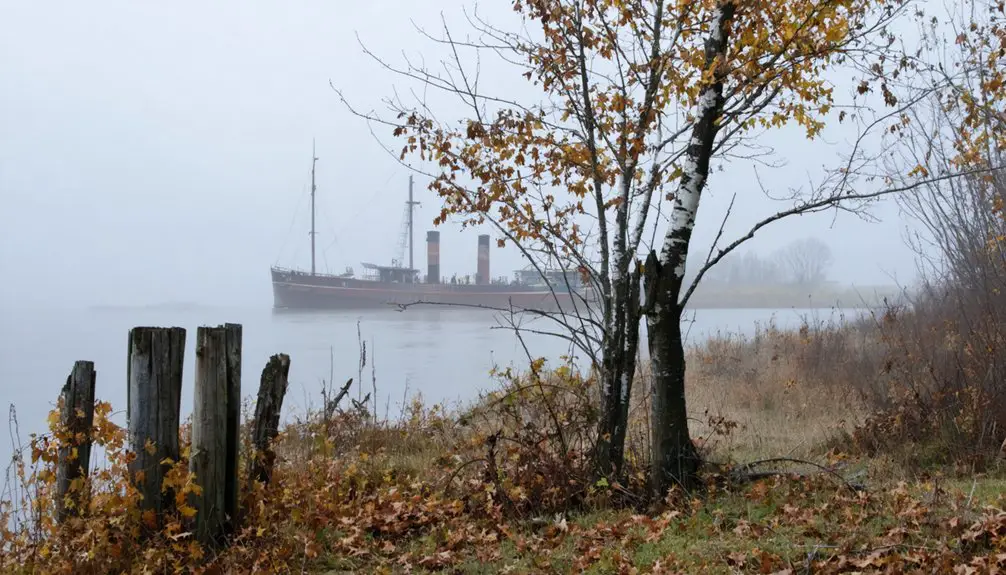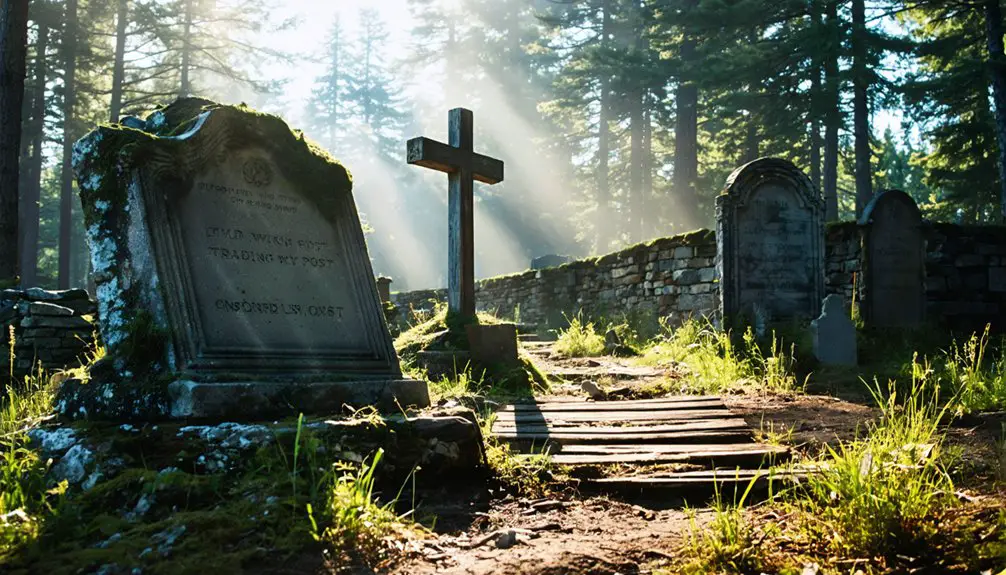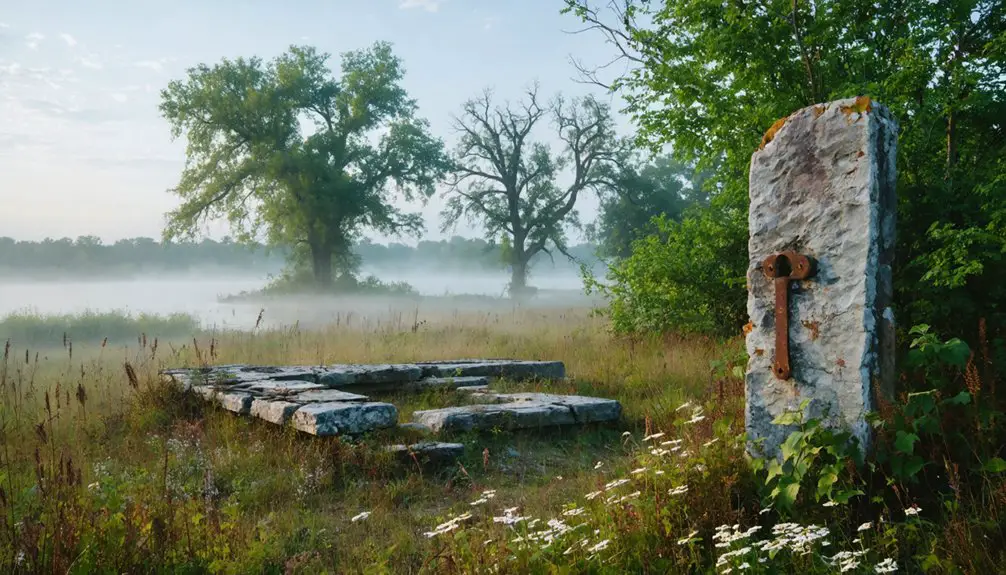You’ll discover Old Crow Wing at the strategic meeting point of the Mississippi and Crow Wing Rivers, where a vibrant frontier town once thrived. From the 1830s to 1860s, this bustling community of 600-700 residents served as a crucial trading hub where Ojibwe, European settlers, and Métis people exchanged goods and cultures. Though the town’s decline began in 1867 after forced Indigenous displacement and being bypassed by the railroad, its rich multicultural legacy lives on in preserved structures and stories.
Key Takeaways
- Old Crow Wing, located at the Mississippi-Crow Wing Rivers confluence, was abandoned after being bypassed by the Northern Pacific Railroad in favor of Brainerd.
- The town’s decline began in 1867 with forced Indigenous displacement, loss of county seat status, and subsequent economic downturn.
- Once thriving with 600-700 residents, the settlement was a major trading hub between Indigenous peoples and European settlers.
- The site is now preserved within Crow Wing State Park, featuring the historic 1849 Beaulieu House and archaeological remains.
- The ghost town’s legacy includes preserved trading post foundations, interpretive trails, and placards telling stories of its multicultural past.
The Meeting of Two Rivers: A Strategic Location
A natural crossroads of waterways defined Old Crow Wing’s strategic importance in Minnesota’s early development.
You’ll find this historic settlement at the meeting point of the Crow Wing and Mississippi Rivers, where a distinctive wing-shaped island marked the confluence that gave the river its name.
The location’s river navigation advantages were unmatched, with the Crow Wing River’s clear waters and low gradient providing ideal conditions for canoe travel.
The pristine Crow Wing River flowed gently through the landscape, creating perfect waterways for native canoes to glide effortlessly downstream.
The rivers’ junction created a strategic trade hub, connecting vast territories across central Minnesota.
You’d appreciate how the dendritic drainage pattern formed natural pathways for commerce between Native Americans, European settlers, and fur traders.
Today, the site encompasses over 2,000 acres of protected land.
The site’s rich biodiversity, featuring diverse forests, wetlands, and prairie ecosystems, supported the bustling community that grew around this essential river crossing.
The virgin white pine forests that once dominated the region provided abundant resources for the early lumber industry before being replaced by jack pine.
Native American Heritage and Cultural Significance
Long before European settlers recognized the strategic value of the river confluence, Indigenous peoples maintained deep cultural and spiritual connections to Old Crow Wing’s landscape.
The area’s rich historical narratives showcase the cultural resilience of Dakota and Ojibwe communities who called this land home for thousands of years. The strategic location at the confluence of rivers made it an essential hub for Indigenous trade and commerce. After the War of 1812, trade restrictions reshaped how goods moved through the region.
- The site served as a significant gathering place where Indigenous traditions flourished through hunting, fishing, and inter-tribal negotiations.
- Community identity evolved through multicultural interactions, as Ojibwe, Métis, and Euro-American settlers formed economic partnerships in the fur trade.
- Despite becoming a ghost town, heritage preservation efforts continue to honor the Indigenous presence through Crow Wing State Park’s interpretive programs.
You’ll find that Old Crow Wing’s Native American legacy remains deeply woven into the region’s cultural fabric, reflecting centuries of Indigenous stewardship and adaptation.
Early Trading Post Era and European Settlement
When European traders first recognized the strategic value of Old Crow Wing’s location at the confluence of the Mississippi and Crow Wing rivers, they established an essential trading hub that would shape the region’s development for decades to come.
You’ll find that James McGill pioneered early trading practices here in 1771, followed by Allan Morrison’s permanent trading post in 1823.
The settlement flourished as a vibrant center of cultural exchanges, where French Canadian voyageurs, Métis traders, and European settlers converged to trade furs, buffalo hides, and manufactured goods along the Red River Trail.
By 1839, Crow Wing had evolved from a simple trading post into a bustling community. William Aitkin operated a successful trading business, exchanging various goods with local Indian tribes for valuable furs.
The 1845 opening of the East Woods Trail further cemented the town’s importance, making it an indispensable stop for ox cart caravans between Pembina and St. Paul.
The Bustling Years: Commerce and Community Life
If you’d visited Old Crow Wing during its peak years, you’d have witnessed a bustling marketplace where Ojibwe and European traders exchanged furs, food, and tools along the strategic confluence of the Mississippi and Crow Wing rivers.
The town’s position along the Red River Trail connecting Canada to St. Paul made it an indispensable commercial center, with merchants capitalizing on both water and land routes to move their goods.
The diverse community of roughly 600-700 residents created a vibrant trading culture where Indigenous and European practices merged, establishing one of Minnesota’s most significant multicultural commercial hubs of the era.
The town’s influence grew significantly in the 1840s as it became a major stop along the ox cart route, transforming into a vital center for Minnesota’s early development.
Trade Along River Routes
As the confluence of the Mississippi and Crow Wing rivers created a natural transportation hub, Old Crow Wing flourished as a crucial trade center in the early 1800s.
You’d find bustling river trade networks connecting communities from Canada to St. Paul, with Allan Morrison’s ferry service enhancing cross-river transportation. The strategic location transformed Old Crow Wing into a crucial supply station where diverse cultures converged to exchange goods freely. The establishment of trading routes helped settlers acquire seed during crop failures by sending expeditions via the Mississippi River.
- American Fur Company traders exchanged merchandise and furs with Indigenous peoples
- Ox cart caravans transported buffalo hides, pemmican, and manufactured goods along the Woods Trail
- French Canadian voyageurs navigated waterways, strengthening trade relationships between settlements
The rivers served as natural highways, letting independent traders bypass the Hudson’s Bay Company’s monopoly while fostering economic freedom and cultural exchange between Indigenous peoples, Métis, and European settlers.
Mixed Cultural Market Life
During its peak years in the mid-1800s, Old Crow Wing thrived as a vibrant multicultural marketplace where nearly 700 residents – split evenly between Ojibwe and European settlers – created a unique community atmosphere.
You’d find a rich tapestry of cultural exchanges at the trading posts, where tools, food, and everyday necessities changed hands alongside traditional fur trades.
The Métis people, born of Indigenous-European unions, brought distinctive customs and languages that shaped the market dynamics.
Local merchants adapted their offerings to serve both settler and Indigenous needs, while blacksmith shops and general stores fostered economic interdependence.
You’d witness market days filled with both imported goods and indigenous harvests, as the community’s strategic location along the Red River Trail and river routes made it a natural hub for commerce and cultural integration.
The remnants of these trading activities can still be explored today, with historic ruins telling the story of this once-bustling marketplace.
Both Catholic and Lutheran missions established their presence in the area, serving the spiritual needs of the diverse trading community.
Fur Trading Economic Hub
While numerous trading posts dotted Minnesota’s frontier landscape, Old Crow Wing emerged as one of the region’s most prosperous fur trading hubs thanks to its prime location at the confluence of the Mississippi and Crow Wing rivers.
The strategic position along the Red River Trail fueled remarkable economic growth, as traders capitalized on both water and land routes to move their goods. By the 1840s, the village had become a vital outfitting center for the countless oxcart trains traversing the region.
- Allan Morrison’s 1823 American Fur Company post established the foundation for decades of thriving commerce.
- A diverse mix of traders – including French Canadians, Métis, and European-Americans – created a competitive marketplace.
- Indigenous partnerships, especially with the Ojibwe people, proved essential to the fur trade’s success, providing crucial knowledge and resources.
This economic powerhouse attracted waves of settlers and entrepreneurs, transforming Old Crow Wing into an important commercial center that shaped Minnesota’s early development.
Political Power and Military Presence
The establishment of Fort Ripley in 1848 marked a pivotal shift in the political dynamics of Minnesota’s frontier region.
You’ll find the fort’s military influence extended far beyond its 90-square-mile reservation, serving as a powerful symbol of federal territorial control between the Mississippi and Crow Wing Rivers.
The fort’s strategic location helped shape the area’s development, as it mediated conflicts between the Eastern Dakota and Ojibwe peoples while overseeing the Ho-Chunk relocation.
Fort Ripley’s position was crucial in managing tribal relations and supervising Native American movements across Minnesota’s contested frontier territories.
During the U.S.-Dakota War of 1862, you’d have seen settlers seeking refuge within its walls.
The military presence wasn’t just about defense – it transformed Crow Wing into a significant political hub, where essential negotiations between tribal nations and the government took place, fundamentally altering the region’s power structure.
A Tale of Two Communities: Ojibwe and European Coexistence

You’ll find that Old Crow Wing’s daily life centered around vibrant cultural exchanges between Ojibwe and European settlers, who established mutually beneficial trade relationships at the town’s bustling riverside markets and trading posts.
The community’s success relied heavily on Ojibwe knowledge of local resources and hunting grounds, while European traders supplied manufactured goods and tools that enhanced traditional Indigenous practices.
This cooperative arrangement fostered a unique shared village life where both communities maintained their distinct cultural identities while participating in joint economic and social activities at places like the Chapel of St. Francis Xavier.
Cultural Trade Relations
Located at the strategic confluence of the Mississippi and Crow Wing Rivers, Old Crow Wing emerged as a vibrant multicultural trading hub where Ojibwe and European settlers forged mutually beneficial partnerships during the late 18th century.
The trade partnerships fostered deep cultural exchange between the communities, with a population of roughly 600-700 residents split evenly between both groups.
- Ojibwe provided valuable fur pelts while Europeans supplied manufactured goods like metal tools, firearms, and cloth.
- Trading posts served as economic and social centers where both communities maintained diplomatic relations.
- The Métis population represented successful cultural blending through intermarriage between Ojibwe and Europeans.
This cooperative spirit created a unique community where Europeans adopted aspects of Ojibwe culture while indigenous people adapted their traditional practices to participate in new economic opportunities.
During Old Crow Wing’s peak years, nearly 700 residents from Ojibwe and European backgrounds shared a remarkable daily existence along the Mississippi and Crow Wing Rivers.
The community dynamics reflected a unique multicultural hub where Ojibwe, Euro-Americans, and Métis families lived side by side, engaging in fur trading, hunting, and fishing to sustain their livelihoods.
Daily interactions centered around the bustling riverfront, where you’d find mixed families working together, many formed through marriages between European traders and Ojibwe women.
Their children, often of mixed heritage, navigated both worlds despite complex social standings within the Ojibwe clan system.
The village’s shared spaces fostered diverse cultural practices, creating a distinctive blend without full assimilation, while maintaining respect for each community’s traditions and customs.
The Path to Abandonment
The path to Old Crow Wing’s abandonment began with the forced displacement of its Indigenous inhabitants in 1867, when U.S. government treaties compelled Ojibwe residents to relocate to the White Earth Indian Reservation.
This displacement impact devastated the town’s cultural and economic foundation, triggering a chain of events that would seal its fate.
The town’s decline accelerated through three major blows:
- Loss of political status as county seat, which shifted administrative functions elsewhere
- Northern Pacific Railroad’s bypass in favor of Brainerd, isolating the town from crucial trade routes
- Rapid economic decline as businesses closed and residents sought opportunities elsewhere
Legacy in Stone and Stories

Standing at the confluence of two mighty rivers, Old Crow Wing‘s enduring legacy lives on through both its physical remnants and rich oral traditions.
You’ll find the historic Beaulieu House, built in 1849, standing as a representation of the town’s multicultural heritage and the influence of Métis fur traders. Archaeological discoveries reveal the original town layout, while reconstructed pathways guide you through the once-bustling settlement.
Through community storytelling preserved on historic placards, you’ll learn firsthand accounts of life in Old Crow Wing, from the indigenous peoples who first called it home to the European settlers who later arrived.
The site’s protection within Crow Wing State Park guarantees that these physical and cultural treasures continue to educate visitors about this significant chapter in Minnesota’s history.
Exploring the Historic Site Today
Modern visitors to Old Crow Wing can explore this historic settlement through an extensive network of marked trails and a reconstructed boardwalk that winds through the original town layout.
You’ll need a state park pass to access this remarkable site, where historical preservation efforts have maintained the Clement Beaulieu house – Minnesota’s oldest surviving building outside the metro area.
Your visitor experiences will include:
- Reading informative placards featuring firsthand accounts at former building sites
- Walking the carefully preserved grounds that showcase the town’s multicultural heritage
- Engaging with seasonal activities from hiking to cross-country skiing
The site offers a unique blend of natural beauty and frontier history, allowing you to step back in time while enjoying the surrounding forest and riverside views of this significant trading post community.
Frequently Asked Questions
Were There Any Notable Crimes or Lawlessness in Old Crow Wing?
You won’t find documented crime incidents in historical records. The town’s trading post status, nearby Fort Ripley’s law enforcement, and cooperative relations between settlers and Ojibwe maintained relative order.
What Diseases or Epidemics Affected the Town’s Population?
While disease outbreaks affected the region’s indigenous peoples before settlement, you’ll find no specific documented health impacts unique to Old Crow Wing beyond common frontier-era illnesses like tuberculosis and influenza.
How Did Residents Survive the Harsh Minnesota Winters?
You’d survive through winter adaptations like layered fur clothing, sturdy log cabins with wood stoves, preserved food in root cellars, and shared community survival strategies for hunting, trapping, and trading.
What Type of Entertainment and Social Activities Existed in the Town?
You’d find yourself joining social gatherings at trading posts, celebrating local festivities with both Ojibwe and settlers, enjoying riverside events, participating in cultural ceremonies, and sharing stories around communal meals.
Did Any Famous Outlaws or Historical Figures Visit Old Crow Wing?
Powerful politicians and prominent pioneers visited, including President Andrew Johnson meeting ten Ojibwe chiefs in 1867. You’ll find fur trader James McGill and influential leader Hole-in-the-Day among famous visitors of historical significance.
References
- https://kids.kiddle.co/Old_Crow_Wing
- https://www.startribune.com/ghost-towns-minnesota-nininger-forestville-old-crow-wing/601169483
- https://daytripper28.com/once-thriving-now-forgotten-the-rise-and-fall-of-old-crow-wing-minnesota/
- https://en.wikipedia.org/wiki/Old_Crow_Wing
- https://www.atlasobscura.com/places/old-crow-wing
- https://en.wikipedia.org/wiki/Crow_Wing_River
- https://www.fromthenorthcountry.com/wp-content/uploads/2017/08/crowwing.pdf
- https://parksandtrails.org/state-parks/crow-wing/
- https://twopaddles.org/about-the-mississippi-river
- https://www.dnr.state.mn.us/state_parks/park.html?id=spk00139



